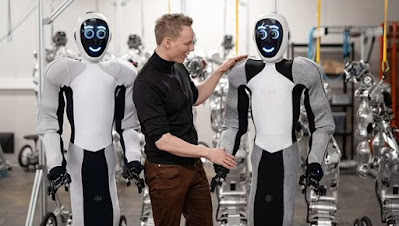DAILY INNOVATION BRIEF by Maryanne Kane, Journalist
DAILY INNOVATION BRIEF
By Journalists Edward Kane & Maryanne Kane
BIG ADVANCEMENT IN AUTONOMOUS AI ROBOTS
Source: 1X Robotics
- A world leader in AI, California-based Open AI, and Norwegian startup 1X Robotics are collaborating on a new generation of breakthrough, AI-enabled robots called Eve. Here are some key facts:
- 1X Robotics is developing autonomous, AI enabled humanoid robots that are powered by Open AI's AI chips
- The AI robots are multi-taskers and experts say their impact could be "transformative"
- The robots can operate on their own with no need for human guidance
- Here are a few of the ways this robot is making history:
- Its self-charging ability - it can charge itself
- It responds to its environment in real-time and takes immediate action
- Has quick reflexes thanks to advanced neural network
- Learns and adapts in real-time
- Innovative new hand design that allows it to precisely grip and manipulate objects
- Vision-based neural network to rapidly process visual information
- Trained on data rather than code
- One of the first targeted uses is for transformative home automation at a highly advanced level
- The collaboration between Open AI and 1X Robotics is being viewed as a turning point in autonomous robots for home and business.
APES HAVE A GREAT SENSE OF HUMOR - NEW SCIENCE
Source: Stock
- A new British scientific study finds that apes have a great sense of humor. Here's what we know:
- Published by the Royal Society B (Biological Sciences), the study shows that apes like to prank one another
- The scientists studied social interactions of chimpanzees, gorillas, bonobos and orangutans, analyzing their body movements and facial expressions
- Here are some specific findings on the teasing going on among apes:
- Offering and then withholding objects from fellow apes
- Tapping someone on the wrong shoulder to elicit misguided attention
- Waving objects to get someone's attention
- The scientists discovered 18 distinct teasing behaviors
- Depending on the species, we share roughly 98% of our DNA with great apes
- The study provides important new insights into not only ape behavior but our own
- Specifically the playful teasing behavior of human infants may have been present in ape/human common ancestors 13 million years ago
- Additionally apes use sign language to communicate
- When they touch their lips they're saying they want food
- When they scratch their chest, they're saying they want to be groomed
- There are more than 100 gestures that apes use to specifically communicate, according to scientists at the University of St. Andrews
- So, the next time someone says that you have the brain of an ape, you might want to say "thanks" as apes have a great sense of humor, know what they want to eat and when they need a bath -- which is more than we can say about some people.
For more news stories like these,





%20(1)%20(1)%20(3)%20(2)%20(2).jpg)


Comments
Post a Comment